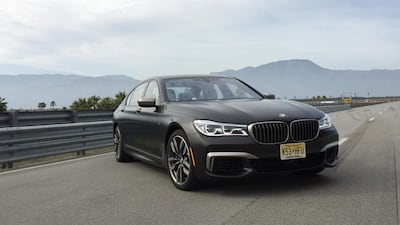At the rarefied end of the car-engine spectrum, the question that premium automakers seem to ask themselves often isn’t “why?” but “why not?” Sure, they could ponder why anybody needs an extra-sporty version of an already-pretty-speedy top-end model, but they would rather go with: why not just screw together the largest unit possible and have some fun blasting off towards the horizon?
There’s certainly an element of that logic behind BMW’s flagship M760Li xDrive, which jams a V12 into the 7 Series and almost gives it the sports treatment – although BMW is keen to let everybody know that it’s not a full M7 per se. There’s an anniversary motivating the whole thinking, too: this year marks three decades since the Bavarian outfit first dropped a V12 monster into the 7 Series. With the current generation relying on V8s, what better time to re-up the cylinder count by 50 per cent?
This particular 6.6L engine pushes out a not-inconsiderable 610hp and 800Nm of torque, delivered via the all-wheel xDrive system. It will catapult you to 100kph from idling in a claimed 3.7 seconds. Top speed is limited to 250kph, unless you shell out for the optional M Driver’s Package, in which case it will keep on going until a reckless 305kph.
And if you were in any danger of forgetting what’s powering all these figures, there’s a big ol’ V12 logo plastered unsubtly to the right of the electronic parking brake on the central console; those about to be left in your wake will also be reminded of the total cylinders thanks to the V12 insignia on the C pillars.
Counter argument: Engine downsizing is getting up to speed but is smaller really better?
There’s no denying that it feels nimble for such a sizeable vehicle when I put a matte-black test car through its paces at the BMW Performance Center at the Thermal racetrack near Palm Springs, California. But it stands to reason that if this isn’t a full M thoroughbred, it’s more important what it does on the road.
Which is why after a spell of rather nondescript highway driving to get out of town, I head for the twisty mountain roads south-west of the city, motoring past kilometres of conifers on single-carriageway roads just large enough for two cars of such dimensions to comfortably pass each other. It does a spirited impression of a slightly miffed hellion when you give it some fire, and it’s one of the best-looking 7 Series variants in recent memory, but despite that and its capable handling and effortless grunt, there’s a little something missing in the “big is better” stakes. Luckily, I think I know where to find it.
While BMW is busy having a comparatively polite blowout, Bentley has consistently associated itself with such upsized mantra for almost a century and shows few signs of stopping. There’s nothing as middle class as a V12 in its latest Bentley Continental GT Speed; only the finest W12 formation will do for the stately British marque.
While the ice-white exterior of my test car is demure in the extreme, the garish red-and-cream leather interior, wrapped around lashings of carbon fibre, is in danger of bringing back bad memories. Specifically, days when the Crewe-produced cars were often associated with footballers – and their wives – who inhabited the mansions of the surrounding Cheshire countryside. But that’s where those notions stop. This is a real driver’s car.
In the late 1980s/early 1990s, when one arm of hardcore punk-rock music morphed into a challenging headlong rush of noisy guitar mayhem, some wag coined the term “powerviolence”. And while that DIY scene is about as far removed from Bentley as the proverbial chalk and Cheddar, the label fits when you engage Sport mode and get uncompromising with your right foot. It’s probably an awful thing to do in terms of a car’s general health, but during four days with the GT Speed, my favourite trick becomes flicking the gearstick down into Sport while accelerating. The change from angry dog to rabid wolf is startling; the lurch is addictive; the noise is positively glorious.
It does possess an extra 23hp and 40Nm compared to the BMW, but those comparatively fine margins feel like a chasm. And it manages all this despite weighing 140 kilograms more.
The pop-up spoiler is adjustable via two buttons on the central console, which is frankly no end of fun at traffic lights, making fellow queuers’ eyes bulge. There are generous doses of character inside, too, with seamless design delights such as the gearstick button, which is disguised as the Bentley “B” atop it, plus massage front seats and seat cooling as well as warming.
OK, so the comparative elements are far from fair: you will be about Dh300,000 richer should you plump for the BMW over the Bentley. The latter car proves one thing, however: such upsized engines might make you toss and turn in your sleep at night with the guilt of catalysing Earth’s destruction, with fuel consumption that you can almost see on the petrol gauge when your right foot hits the floor, but big is here to stay for the foreseeable future. And at least you will go to bed with a whopping great smile on your face.
Three more monsters
Lamborghini Aventador S. Courtesy Lamborghini
Lamborghini Aventador S
The revamped supercar comfortably shatters the 700hp mark thanks to its meaty 6.5L V12.
Dodge Viper
The 2017 model, with its 8.4L V10, is the last dance for the serpentine two-seater – Fiat Chrysler is ending its production.
Bugatti Chiron
The most ridiculous of the lot: the 8.0L, quad-turbo W16 has 1,500hp and hits 420kph.
aworkman@thenational.ae

